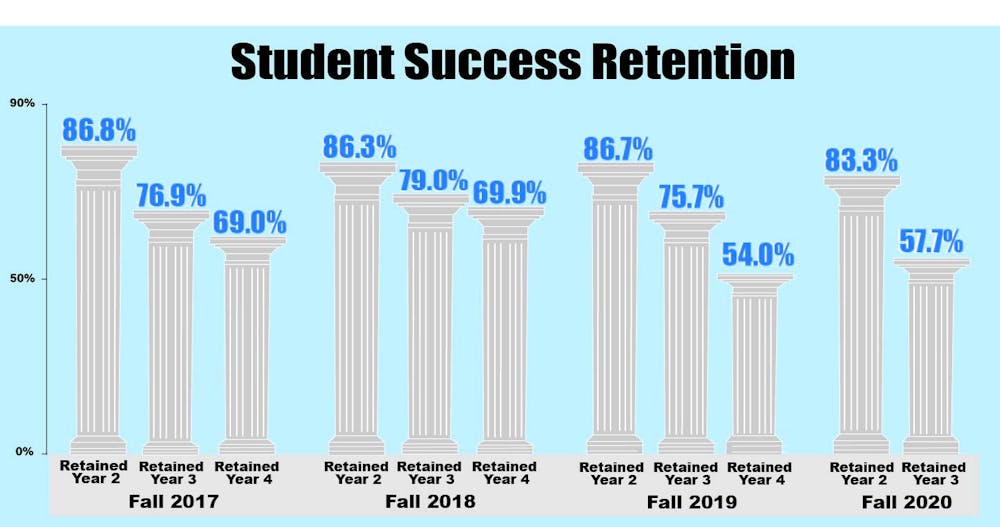Undergraduate students who attended UB during the COVID-19 pandemic are returning for subsequent semesters at some of the lowest rates the university has seen dating back to 2009, the earliest year for which data was available.
The fall 2020 cohort year-three retention rates and fall 2019 year-four retention rates are both far below the typical average. Only 57.7% of students who entered UB in fall of 2020 returned for their third year this fall, according to UB Factbook. Only 54% of the fall 2019 cohort returned for their fourth year this fall. The average for third-year and fourth-year retention rates were 77.8% and 68.1% respectively for the freshmen classes of 2009-2018.
“While our retention rate is not where we would like it to be, it is still above the average of all U.S. colleges granting four-year degrees,” Dawn Reed, director of Interdivisional Marketing and Communications, said.
The national average retention rate for undergraduate students who started college in the fall of 2020 was 75.4%, according to a Department of Education report.
The fall 2019 cohort lost 21.7% of students between the 2021-22 and 2022-23 school years, dropping from 75.7% of students retained to 54%. While fourth-year data for the fall 2020 cohort will not be released until 2023, the group could set another record low if they continue the 2019 cohort’s trend.
Data for the fall 2021 is not yet available.
Some students left the university due to COVID-19-related factors such as remote learning, social distancing and vaccination and mask mandates, Reed said.
By spring 2022, UB had lifted most social distancing and mask mandates. But as UB and the world lifted restrictions, many students still did not return for the fall 2022 semester.
“The impact of the COVID-19 pandemic on higher education will be felt for many years to come,” Reed said. “All aspects of the university environment have experienced changes.”
The COVID-19 pandemic compounded the reasons students typically leave, such as a lack of academic success, Reed says. Half of the first-year students who leave UB are in good academic standing, and may have left due to family issues, financial problems or personal difficulties, or simply because they weren’t admitted to their desired major.
Black students have lower than average retention rates, but the difference has become more pronounced in recent years. Just 42.1% of Black students in the 2019 cohort returned to UB for their fourth year, and 48% of those in the 2020 cohort returned for their third year this fall. That’s compared to 64.3% of Black students from the fall 2018 cohort who returned for a fourth year.
International students have also seen a decrease in retention rates. Reed said that international students usually return to UB at higher rates than domestic students. Restrictions and guidelines resulting from COVID-19 made it difficult for many international students to return to UB. Factors such as visa issues, the financial costs of traveling and family obligations also play a role in international students’ decisions to remain at the university.
“The university is aware of the lower retention rates of students from historically underrepresented backgrounds,” Reed said. “A variety of programs are currently in place to support students as they transition to college.”
Some of these programs include peer mentor groups, living learning communities, summer bridge programs, the Cora P. Maloney Center, Educational Opportunity Program and Proud To Be First, which supports first-generation college students. The President’s Advisory Council on Race is also working on programs to support students of all racial and ethnic backgrounds.
“The university is committed to supporting all our students,” Reed said. “Our focus is not simply on retention rates, but overall persistence and student success — our goal is to enroll, retain and graduate a diverse group of students.”
UB’s retention goals for 2022 and 2025 are to retain 91% and 93% of first-year students, respectively, according to their website. The current first-to-second-year retention rate is 83.3%.
Reed says the 2022 and 2025 goals on the university’s Retention Effect webpage were last updated before COVID-19, and she is not aware of a new date to reach 90% retention, a goal that was outlined in President Tripathi’s fall 2022 State of the University Address.
“The university is deeply committed to the success of our students,” Reed said. “Assessment of services is ongoing, and new programs are considered as new and changing needs of our students are identified.”
The news desk can be reached at news@ubspectrum.com





